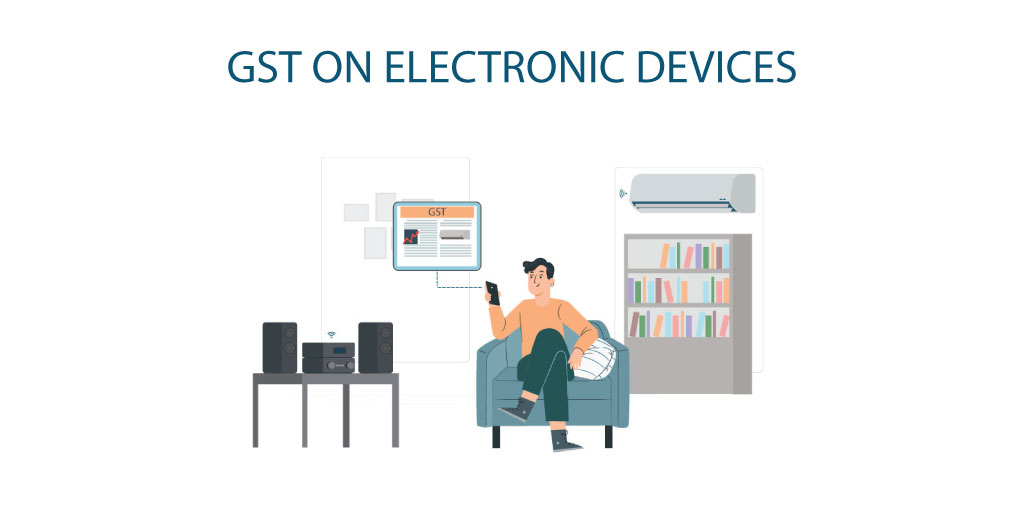Goods and Services Tax (GST) has streamlined taxation in India, making it simpler for businesses and consumers alike. Among various categories of goods, electronics have a significant place, and understanding how GST applies to electronics is crucial. This blog explores the impact of GST on electronics, detailing the rates, implications, and benefits for both buyers and sellers.

GST on Electronics
Under the GST regime, electronics are categorized under different tax slabs based on their nature and use. Here’s a breakdown of GST rates applicable to various electronic items:
1. Consumer Electronics
Consumer electronics, such as televisions, smartphones, and laptops, generally fall under the 18% GST slab. This rate applies to most electronics that are used for personal or household purposes.
2. Electronic Appliances
Electronic appliances, including refrigerators, air conditioners, and washing machines, also fall under the 18% GST rate. This consistent rate across major categories helps maintain transparency and simplifies the tax structure for both consumers and manufacturers.
3. Computers and Peripherals
Computers and related peripherals, such as printers and scanners, are subject to a GST rate of 18%. This rate ensures that the tax burden on technology and business tools remains standardized.
4. Luxury and High-End Electronics
Certain high-end electronic items, particularly luxury electronics like premium televisions and advanced home theater systems, are subject to a higher GST rate of 28%. This higher rate reflects the luxury status of these items and aims to balance the tax structure for various consumer segments.
5. Certain Electronic Goods
Some specific electronic goods, including certain types of high-tech equipment and advanced electronics used in specialized industries, may also fall under the 28% GST rate. This includes items that are considered non-essential or luxury in nature.
Impact of GST on Electronics Prices
Price Adjustments
One of the significant impacts of GST on electronics is the adjustment in prices. Prior to GST, electronics were subject to various state and central taxes, which could result in a complex tax structure. With GST, the tax rates are unified, which can lead to either price increases or decreases, depending on the previous tax rates and the new GST slab.
Input Tax Credit
GST provides the benefit of Input Tax Credit (ITC), which allows businesses to claim a credit for the tax paid on inputs used to manufacture electronic products. This feature helps in reducing the overall tax burden on businesses and, in turn, can lead to more competitive pricing for consumers.
GST Compliance for Electronics Businesses
Registration
Businesses dealing in electronics must register under GST if their turnover exceeds the prescribed limit. This registration is mandatory for collecting GST from customers and for claiming ITC.
Invoicing and Reporting
Proper invoicing and reporting are crucial for compliance. Businesses must issue GST-compliant invoices and file regular GST returns. This process ensures transparency and helps avoid penalties.
Accounting
Accurate accounting for GST on electronics involves maintaining records of sales, purchases, and ITC claims. Using accounting software that supports GST features can simplify this process.

Benefits of GST on Electronics Sector
Simplified Tax Structure
GST has simplified the tax structure by replacing multiple taxes with a single tax, reducing complexity for both businesses and consumers. This unified approach helps in better tax compliance and easier financial planning.
Enhanced Transparency
The implementation of GST has enhanced transparency in the electronics sector. The system ensures that all transactions are recorded and reported, which reduces tax evasion and increases accountability.
Improved Market Competitiveness
With the benefit of ITC and a uniform tax rate, businesses can optimize their pricing strategies. This can lead to more competitive prices in the market, benefiting consumers through better value for money.
Conclusion of GST on Electronics Sector
Understanding GST on electronics is essential for navigating the current tax landscape effectively. Whether you’re a consumer purchasing the latest gadget or a business dealing in electronic goods, knowing how GST impacts prices and compliance requirements can help you make informed decisions. The GST framework aims to create a more transparent, efficient, and competitive market for electronics, benefiting all stakeholders involved.
Feel free to reach out for more information or guidance on how GST affects your specific situation!

I love the detailed explanations.